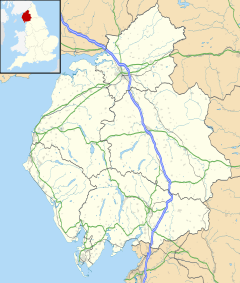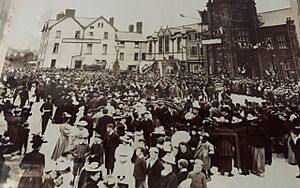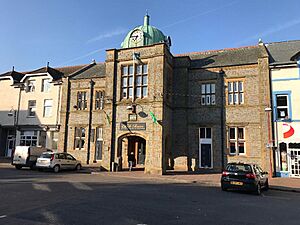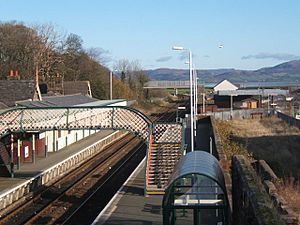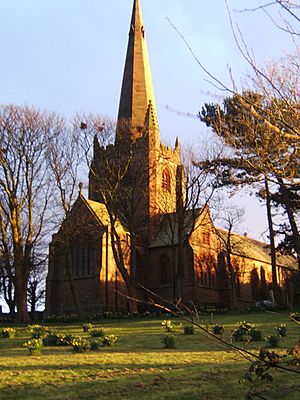Millom facts for kids
Quick facts for kids Millom |
|
|---|---|
| Town and parish | |
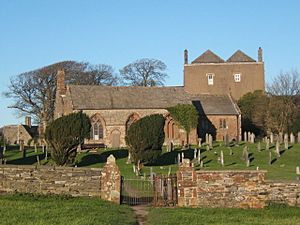 Millom Castle and Holy Trinity Church |
|
| Population | 7,240 (2021) |
| OS grid reference | SD172802 |
| Civil parish |
|
| Unitary authority |
|
| Ceremonial county | |
| Region | |
| Country | England |
| Sovereign state | United Kingdom |
| Post town | MILLOM |
| Postcode district | LA18 |
| Dialling code | 01229 |
| Police | Cumbria |
| Fire | Cumbria |
| Ambulance | North West |
| EU Parliament | North West England |
| UK Parliament |
|
| Tower shape | cylindrical tower with balcony and embattled top, light from a window |
|---|
Millom is a town and civil parish located in Cumberland, Cumbria, England. It sits on the north shore of the River Duddon estuary. The town is just outside the beautiful Lake District National Park. It is about 6 miles (10 km) north of Barrow-in-Furness and 26 miles (42 km) south of Whitehaven.
Millom was built as a new town starting in 1866. It grew around a large ironworks. The town's population reached over 10,000 people by the 1960s. However, it faced challenges after the ironworks closed in 1968. Millom is known as the birthplace of the famous poet Norman Nicholson. It also has strong historical ties to the sport of rugby league.
Contents
History of Millom
Millom is mentioned in the Domesday Book from 1086. This book was a survey of England ordered by William the Conqueror. Millom was part of the Manor of Hougun at that time.
Millom Castle is a very old building. It is a grade I listed building, which means it's very important historically. By 1739, parts of the castle were already falling apart.
In 1251, King Henry III of England gave John de Huddleston, who was the Lord of Millom, permission to hold a market. This helped the town grow. Millom is the most southerly town in the historic county of Cumberland.
The Rise of Industry
A railway station opened in 1850. It was first called 'Holborn Hill Halt'. This was before the new town of Millom was built in 1866. The railway was important for transporting goods and people.
In 1862, there was only a small village called Holborn Hill. It had a railway station, an inn, and a brickworks. By 1899, Millom had grown into a small town. It had many terraced streets, a public library, a police station, banks, hotels, a school, and a market square.
The Hodbarrow iron mines started digging for haematite (iron ore) in the 1850s. The Millom & Askam Iron Company built the Millom Ironworks. The first furnaces were ready in 1866. These industries led to the building of the new town of Millom. To protect the mines from the sea, a large seawall called the Hodbarrow Outer Barrier was finished in 1905. It cost a lot of money and took five years to build.
Both the Hodbarrow Mines and Millom Ironworks closed in 1968. This caused the town's population to drop significantly. In 1967, there were almost 11,000 people. By 1971, there were only about 7,100.
Water Supply and Wartime Role
In 1877, Millom needed more water for its growing population. A dam was built at Baystone Bank to create Baystone Bank Reservoir. This reservoir was used until about 1996. It was later drained, and the valley was returned to its natural state.
During the Second World War, an airfield called RAF Millom was built near Haverigg. It was used to train pilots and air gunners. After the war, this site became HM Prison Haverigg. Millom has faced challenges throughout its history, but its community continues to work towards a better future.
How Millom is Governed
Millom is part of the Barrow and Furness UK Parliamentary constituency. This means that people in Millom vote for a Member of Parliament (MP) to represent them in the UK Parliament. The current MP is Michelle Scrogham. An MP's job is to speak up for the people in their area and help make laws.
For local matters, Millom is part of the Cumberland unitary authority. This local council looks after things like schools, roads, and social services. Millom also has its own parish council, called Millom Town Council. This council deals with local issues and services for the town. The parish is divided into four smaller areas: Holborn Hill, Newtown North, Newtown South, and Haverigg.
The Old Town Hall was finished in 1879. It is an important historical building in the town.
Economy and Jobs
Today, Millom's economy mostly relies on shops, services, and tourism. Many people work in skilled jobs like building and decorating. Others work in hotels, pubs, and shops, especially those near the Lake District National Park. Some people travel to bigger towns like Barrow-in-Furness or Sellafield for higher-paying jobs.
The prison at Haverigg, about 2 miles (3 km) away, is also a major employer in the area. In 2004, Millom was given the status of a Fairtrade town. This means it supports fair prices and good working conditions for producers in developing countries.
Culture and Community
Millom has a lively cultural scene. The Millom Palladium is a theatre and venue that has been open for over 100 years. It is home to the Millom Amateur Operatic Society (MAOS), which started in 1909. Volunteers are working to bring back the cinema to the building.
The Beggar's Theatre is another arts center. It hosts many activities for local talent and welcomes touring theatre groups and comedians.
Norman Nicholson Society
The Norman Nicholson Society celebrates the work of the town's most famous person, Norman Nicholson. He was a poet and writer who lived his whole life in Millom.
Landmarks to Explore
St. George's Church is a tall church with a steeple. It stands on a small hill in the town and can be seen from many miles away.
The biggest natural landmark nearby is Black Combe. This hill is 1,970 feet (600 meters) high. From its top, you can see amazing views of the south-western Lake District. On a clear day, you might even see parts of England, Scotland, Ireland, and Wales!
The Millom Discovery Centre (also known as 'Millom Folk Museum') shows what life was like in Millom in the past. It focuses on how the iron ore mining and iron works shaped the area.
Millom Rock Park is located high up on the edge of the Ghyll Scaur Quarry. From here, you can look down into the working quarry. The park also has 15 large rock samples with information panels explaining them.
Nature Reserves
There are two nature reserves close to Millom, both on the Duddon Estuary. This area is very important for wildlife. Hodbarrow Nature Reserve is owned by the RSPB (Royal Society for the Protection of Birds). It's known for many types of birds, especially in winter. Millom Iron Works Local Nature Reserve is to the east of the town. Both reserves are important for terns, wading birds, and waterfowl. You can also spot birds of prey hunting here.
In 1866, the Hodbarrow Mining Company built a lighthouse to guide ships. Later, in 1905, they built a new seawall and a new lighthouse on it. Both lighthouses still stand today. The newer lighthouse was refurbished in 2004 by the local community.
Getting Around Millom
Millom has its own railway station on the Cumbrian Coast Line. The A5093 road runs through the town. This road is a loop off the main A595. The town council supports the idea of building a road bridge across the Duddon estuary to connect Millom with the Furness peninsula.
Media and News
For local news and TV shows, people in Millom can watch BBC North West and ITV Granada. Local radio stations include BBC Radio Cumbria and Heart North West. There is also a community radio station called CandoFM. The local newspaper for the town is North West Evening Mail.
Education in Millom
Millom School is a secondary school and sixth form. It has an adult education center, a sports pitch, and the "Melvyn Bragg Drama Studio." The studio was opened in 2005.
There are also several primary schools in Millom:
- Millom Infants School
- The Nursery
- St James' Catholic Primary School
- Black Combe Junior School
Places of Worship
Millom's oldest church is Holy Trinity. It is a grade I listed building and dates back to the 12th century. As the town grew, a new church, St George's, was built in 1877. It is a Grade II Listed building and has a beautiful memorial window by artist Christine Boyce. There are also Roman Catholic, Baptist, and Methodist churches, as well as a community church and a Jehovah's Witnesses Kingdom Hall.
Sports and Recreation
Millom Recreation Centre has a large sports hall and a gym. It offers many different sports. Millom has clubs for Crown green bowling, tennis, and cricket.
Millom Rugby League Club is the oldest amateur rugby league club in the world. It was founded in 1873. Millom also has a Rugby Union club, which was formed in the same year, making it one of England's oldest rugby clubs.
Notable People from Millom
- John A. Agnew: A British-American geographer.
- Professor John T Andrews: Born in Millom in 1937, he became a famous geologist. He played rugby for the English Schools team.
- Norman Nicholson: A celebrated poet and author who lived his entire life in Millom. You can see a blue plaque on his house at 14 St George's Terrace.
- Jimmy Settle: An English international footballer born in Millom in 1874.
See also
 In Spanish: Millom para niños
In Spanish: Millom para niños


